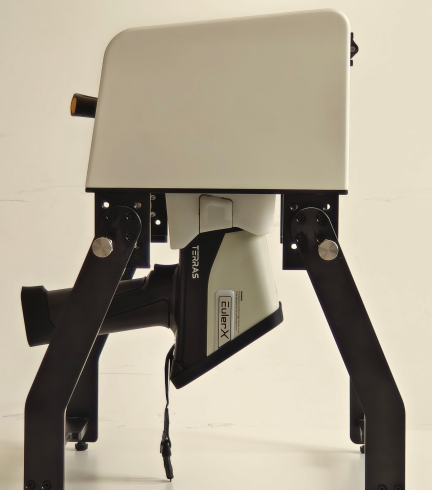
Alloy
A high-tech enterprise focusing on the development and application of X-ray technology products, committed to becoming a leading supplier of X-ray industrial testing solutions.
Considering a Handheld XRF Gun for Sale? 5 Key Questions to Ask Before You Buy
So, you’re in the market for a handheld XRF (X-Ray Fluorescence) analyzer. That’s a significant step forward for any business involved in material analysis, from scrap metal recycling and mining to quality control in manufacturing and environmental testing.
A handheld XRF gun is a powerful investment, promising rapid, on-the-spot elemental analysis that can save you immense time and money. But with a range of models, features, and price points on the market, how do you ensure you’re making the right choice?
Buying the wrong instrument can lead to inaccurate data, wasted capital, and frustrating operational bottlenecks. Before you click "add to cart" or sign a purchase order, you need to ask the right questions—both to your team and to potential suppliers.

Here are the 5 key questions you must answer before buying a handheld XRF gun.
1. What Specific Elements Do I Need to Measure, and At What Concentrations?
This is the most critical starting point. Not all XRF analyzers are created equal. They have different configurations and capabilities optimized for specific applications.
For Scrap Metal & Alloy Verification: You need an analyzer with high accuracy for a wide range of alloying elements (like Ni, Cr, Mo, Cu) and trace elements (like Pb, As) to guarantee material grade and avoid costly mis-identification.
For Mining & Geochemistry: You’re likely focused on trace-level detection of precious metals (Au, Ag), base metals (Cu, Zn, Pb), or "pathfinder" elements. You may need a instrument with a helium purge or vacuum pump to accurately measure lighter elements like Magnesium (Mg), Aluminum (Al), and Silicon (Si).
For Consumer Goods & RoHS Screening: Your primary concern is ensuring compliance by detecting restricted elements like Lead (Pb), Cadmium (Cd), Mercury (Hg), and Bromine (Br) at low concentrations.
The Bottom Line: Clearly define your analytical needs. A supplier should be able to provide detection limit sheets for their instruments that align with your target elements and required concentration levels.
2. What is the Total Cost of Ownership, Not Just the Purchase Price?
The sticker price is only part of the story. A cheaper instrument can become more expensive in the long run. Consider these ongoing costs:
Calibration & Maintenance: How much do annual calibrations or performance verifications cost? Is the hardware robust, or will it require frequent, expensive repairs?
Software & Updates: Are software licenses perpetual, or is there an annual subscription fee? Are future updates included?
Accessories: Do you need a tripod, a protective shield, a helium bottle for a purge system, or extra calibration standards? These can add up quickly.
Training & Support: Is comprehensive training included, or is it an extra charge?
The Bottom Line: Ask for a detailed breakdown of all potential costs over a 3-5 year period. A reliable, well-supported instrument from a reputable manufacturer often provides a better return on investment than a bargain-basement option.
3. How User-Friendly is the Instrument and Its Software?
Your team will be using this device daily. A complex, unintuitive interface can lead to user error, wasted time, and frustration.
Hardware: Is the gun well-balanced and comfortable to hold for extended periods? Is the screen bright and readable in direct sunlight? How long does the battery last on a single charge?
Software: Is the software intuitive with a logical workflow? Can you easily create custom application methods? How simple is it to export data into reports or your existing LIMS (Laboratory Information Management System)?
The Bottom Line: Request a live demo. Have the operators who will actually use the gun test it with your own samples. Their feedback is invaluable. The goal is to get from "power on" to "accurate result" in as few steps as possible.
4. What Kind of After-Sales Support and Service Can I Expect?
Your XRF analyzer is a critical piece of equipment. When it goes down, your operation can grind to a halt. The quality of the manufacturer's support network is paramount.
Service Response Time: What is the average turnaround time for repairs? Do they offer loaner units while yours is being serviced?
Technical Support: Is support local, or do you have to call an international hotline? Is it available in your language and during your business hours?
Training Resources: Beyond initial training, do they offer webinars, online tutorials, and a comprehensive knowledge base?
The Bottom Line: Ask for customer references, specifically in your region and industry. A supplier with a proven track record of responsive, expert support is worth its weight in gold.

Terras EulerX900 Handheld Alloy Analyzer
5. How Does the Instrument Ensure Regulatory Compliance and Safety?
Handling an X-ray device comes with serious responsibility. You must ensure the instrument meets all safety regulations and that your team is fully protected.
Safety Features: All modern handheld XRF guns have built-in safety mechanisms (e.g., proximity sensors that prevent firing unless the gun is pointed at a sample). Confirm the model you're considering has these features.
Regulatory Compliance: Does the instrument comply with your country's radiation safety regulations (e.g., FDA in the USA, Health Canada, etc.)? The supplier should provide all necessary documentation.
Training and Licensing: What is required to own and operate the device in your area? The supplier should guide you through the process of obtaining the necessary licenses and setting up a radiation safety program.
The EulerX900S XRF Spectrometer brings the lab to the field. It instantly and non-destructively analyzes elements from Magnesium to Uranium, identifying metals, alloys, and contaminants on the spot. With a rugged, portable design and intuitive touchscreen, it simplifies reporting via Wi-Fi/USB for QA, scrap sorting, and environmental work.
The Bottom Line: Never compromise on safety. A reputable supplier will treat regulatory compliance not as an afterthought, but as a fundamental part of the sale.
Make an Informed Investment
A handheld XRF gun is more than just a tool; it's a partner in your business's success and efficiency. By taking the time to ask these five crucial questions, you can move beyond the marketing hype and select the analyzer that perfectly fits your technical requirements, operational workflow, and budget.
Don't just find a handheld XRF for sale—find the right one. Your bottom line will thank you for it.
Terra Scientific is a high-tech manufacturer specializing in the development and application of X-ray technology products. We are committed to becoming a world-class provider of X-ray industrial inspection solutions. Terra Scientific currently offers a range of products to global customers, including handheld alloy analyzer, handheld precious metal analyzer, handheld mining analyzer, benchtop precious metal analyzers, in-line analyzer, and spectrometer modules, along with XRF analyzers. We continuously serve global clients in fields such as mechanical manufacturing, metal processing, aerospace, petrochemicals, mining and geology, food safety, environmental protection, and scientific research.
To learn more, please don't hesitate to contact us via email at sales@terra-scientific.com, or visit our website at http://www.terra-scientific.com
Join Us
Subscribe to our email list for updates & promotions.



